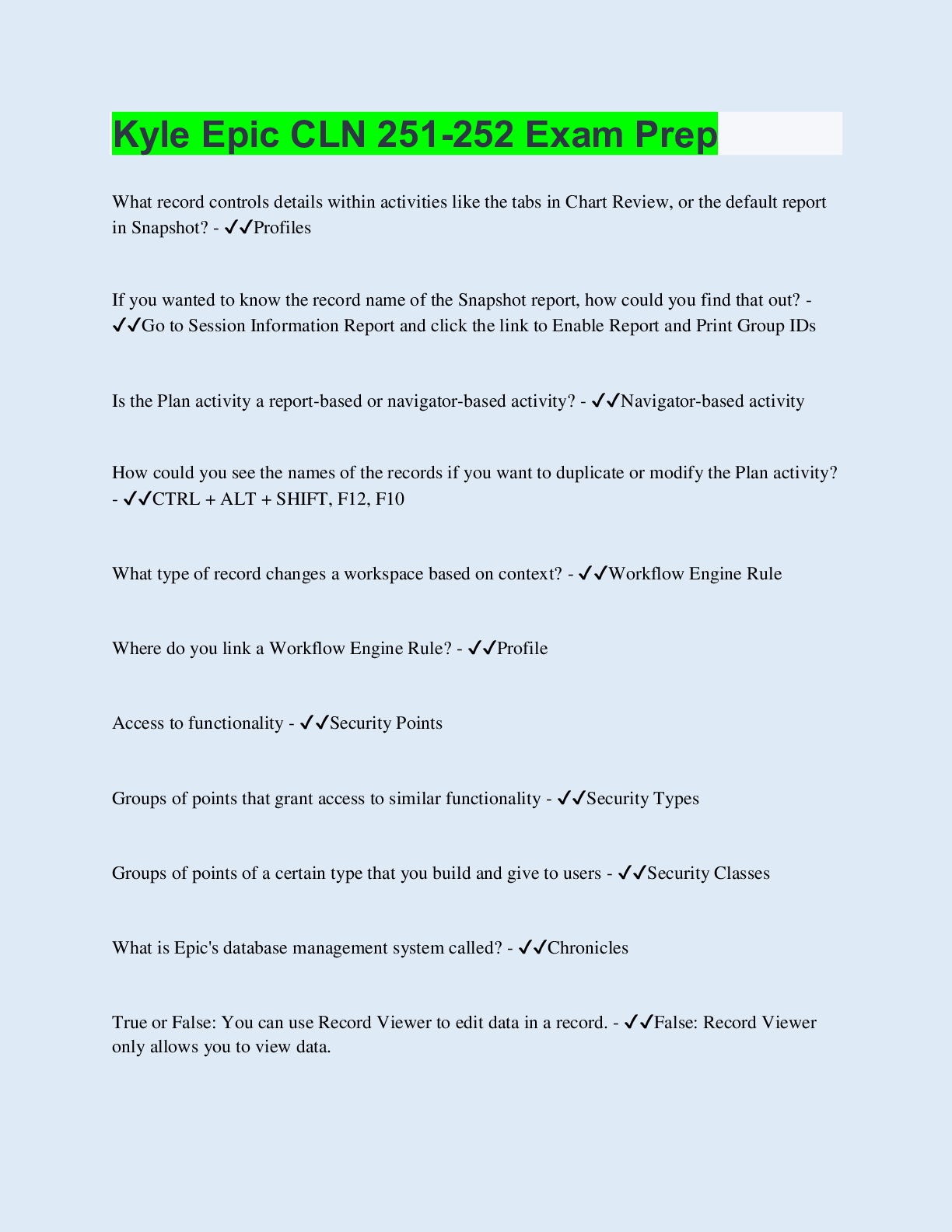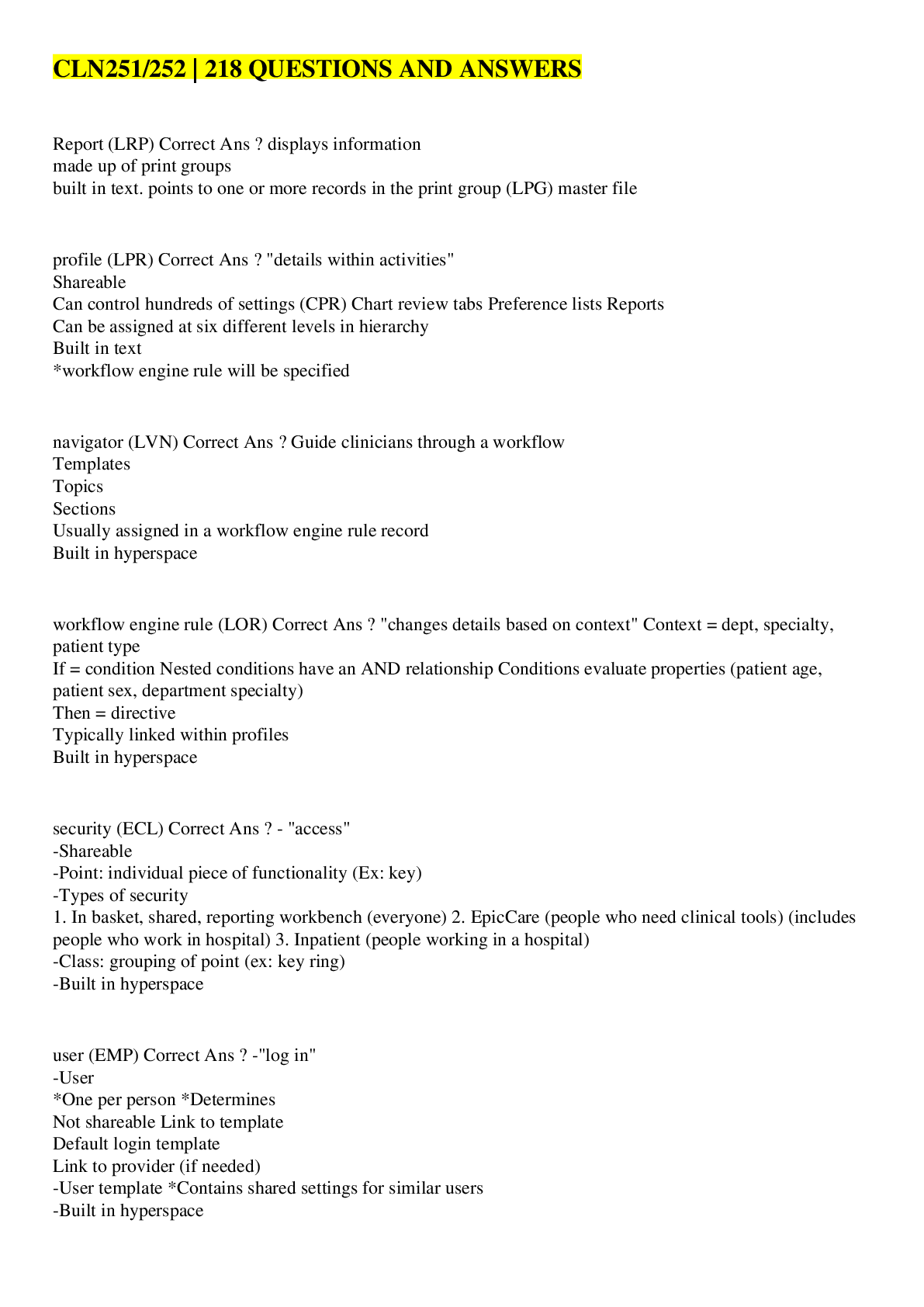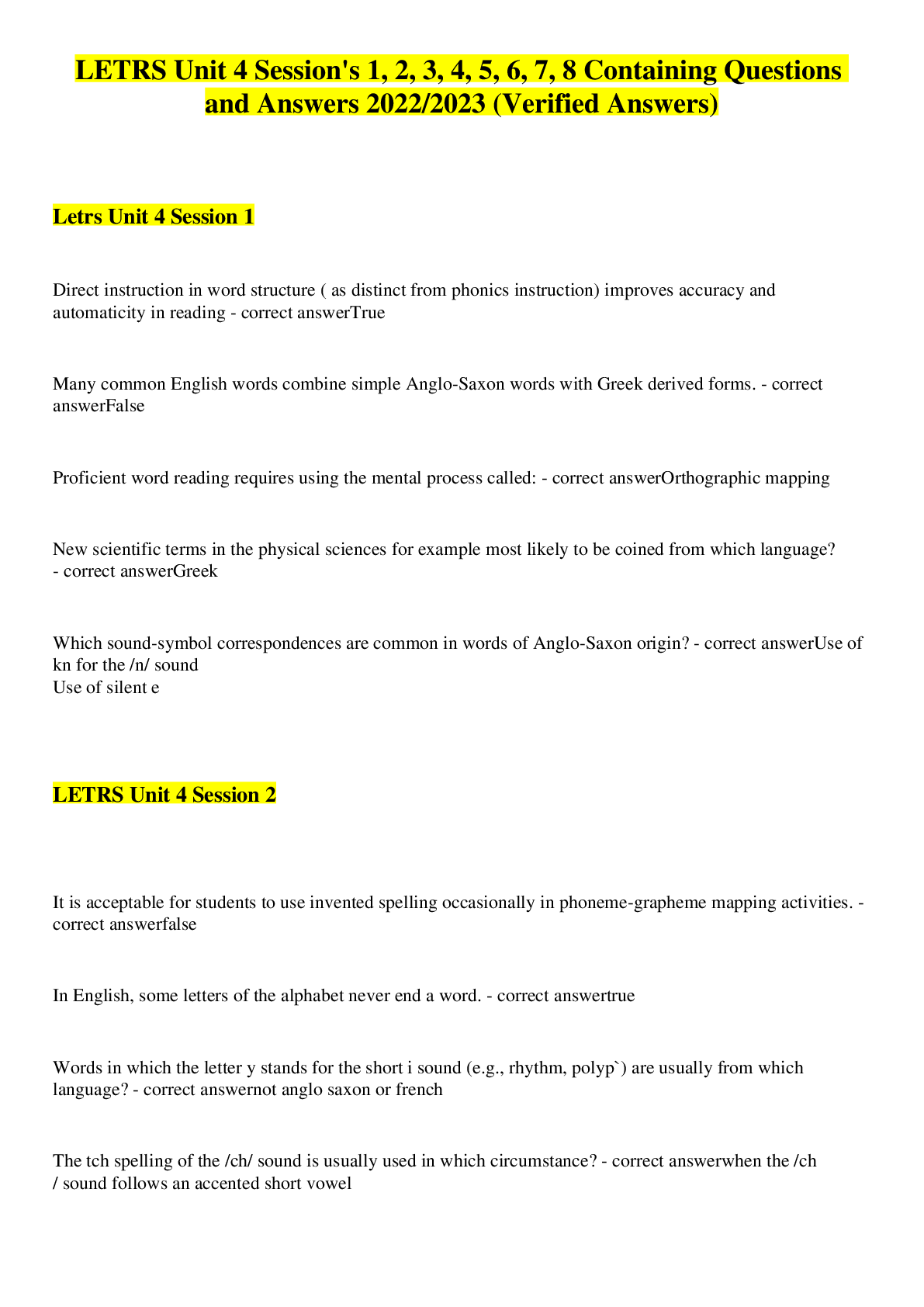AP Exam Review – 2022 Questions and Answers
Document Content and Description Below
psychology - ANSWER the scientific study of behavior and mental processes cognitive neuroscience - ANSWER the interdisciplinary study of the brain activity linked with cognition (including percepti... on, thinking, memory, and language) nature-nurture issue - ANSWER the longstanding controversy over the relative contributions that genes and experience make to the development of psychological traits and behaviors biological perspective - ANSWER the approach that views behavior from the perspective of the brain, the nervous system, genetics, and other biological functions evolutionary perspective - ANSWER the application of principles of evolution, including natural selection, to explain psychological processes and phenomena. psychodynamic perspective - ANSWER A branch of psychology that studies how internal conflicts and unconscious drives influence behavior, and uses that information to treat people with psychological disorders. (Influenced by Sigmund Freud's model of psychoanalysis) behavioral perspective - ANSWER perspective of psychology that sees psychology as an objective science without reference to mental states; sees behavior as the result of conditioning & reinforcement; dominant perspective from 1920s-1960s (a.k.a. the "learning" perspective) cognitive perspective - ANSWER A psychological approach that emphasizes mental processes in perception, memory, language, problem solving, and other areas of behavior humanistic perspective - ANSWER The approach that suggests that all individuals naturally strive to grow, develop, and be in control of their lives and behavior; influenced heavily by ideas of Rogers and Maslow social-cultural perspective - ANSWER approach that emphasizes how behavior and thinking vary across situations and cultures basic research - ANSWER pure research that aims to confirm an existing theory or to learn more about a concept or phenomenon applied research - ANSWER scientific study that aims to solve practical problems psychiatrist - ANSWER a medical doctor who specializes in the diagnosis and treatment of mental disorders; can prescribe medication clinical psychologist - ANSWER holds an advanced degree in psychology but is not a medical doctor; specializes in identifying and treating persons with mental illness, but does not prescribe medication John Watson - ANSWER American psychologist who founded behaviorism, emphasizing the study of observable behavior and rejecting the study of mental processes Charles Darwin - ANSWER Wrote "The Origin of Species" proposed idea of natural selection as primary means of species diversity. His influence appears in psychology's evolutionary perspective. experimental psychology - ANSWER the study of behavior and thinking using the experimental method biopsychosocial approach - ANSWER An integrated approach that incorporates biological, psychological, and social-cultural levels of analysis levels of analysis - ANSWER the differing complementary views, from biological to psychological to social-cultural, for analyzing any given phenomenon psychometrics - ANSWER the scientific study of the measurement of human abilities, attitudes, and traits; also sometimes called "quantitative psychology" developmental psychology - ANSWER A branch of psychology that studies physical, cognitive, and social change throughout the life span educational psychology - ANSWER the study of how psychological processes affect and can enhance teaching and learning personality psychology - ANSWER the study of an individual's characteristic pattern of thinking, feeling and acting social psychology - ANSWER The scientific study of how we think about, influence, and relate to one another industrial-organizational psychology - ANSWER application of psychological concepts and methods to optimizing human behavior in workplaces. human factors psychology - ANSWER A branch of psychology that explores how people and machines interact and how machines and physical environments can be made safe and easy to use counseling psychology - ANSWER A branch of psychology that assists people with problems in living (often related to school, work, or marriage) and in achieving greater well-being community psychology - ANSWER A branch of psychology that studies how people interact with their social environments and how social institutions affect individuals and groups central nervous system (CNS) - ANSWER Division of the nervous system that consists of the brain and spinal cord peripheral nervous system (PNS) - ANSWER the sensory and motor neurons that connect the CNS to the rest of the body somatic nervous system - ANSWER division of the peripheral nervous system that control's the body's skeletal muscles. neuron - ANSWER a nerve cell; basic cell of the nervous system sensory (afferent) neurons - ANSWER neurons that carry information from the receptors to the spinal cord and brain motor (efferent) neurons - ANSWER neurons that carry information from the brain and spinal cord to the muscles autonomic nervous system (ANS) - ANSWER division of the peripheral nervous system involved in the control of (generally unconscious/automatic) bodily functioning through organs and glands; its sympathetic division arouses while the parasympathetic division calms sympathetic nervous system - ANSWER subdivision of the autonomic nervous system responsible for mobilizing the body in times of stress, and preparing for flight or fight parasympathetic nervous system - ANSWER subdivision of the autonomic nervous system responsible for calming the body reflex - ANSWER automatic behavior in response to a specific stimulus; does not involve communication with the brain brainstem - ANSWER the oldest part and central core of the brain; responsible for automatic survival functions and composed of medulla, pons, and reticular formation. pons - ANSWER structure of the brainstem that allows for communication between the cerebellum, cerebral cortex, & brain stem; has nuclei that are important for sleep and arousal medulla - ANSWER base of the brainstem; controls heartbeat & breathing reticular formation - ANSWER band of nerve fibers that run through the center of the brain stem; important in controlling arousal levels cerebellum - ANSWER structure of the hindbrain that coordinates voluntary muscular movements corpus callosum - ANSWER wide band of neural fibers that connects the two hemispheres of the brain limbic system - ANSWER a group of structures located beneath the cerebral cortex that are involved in regulating emotions and motivated behaviors thalamus - ANSWER subcortical structure that relays incoming sensory information to the cerebral cortex and other parts of the brain; a.k.a "sensory switchboard" electroenchephalogram (EEG) - ANSWER device that monitors and records waves of electric activity within the brain; measured by electrodes placed on the scalp positron emission tomography (PET scan) - ANSWER visual display of brain activity that detects where a radioactive form of glucose goes while the brain performs a given task computed tomography (CT scan) - ANSWER imaging technique that involves the production of a large number of X-rays interpreted by a computer MRI (magnetic resonance imaging) - ANSWER imaging technique that involves the use of radio waves and a strong magnetic field to produce a signal that can be interpreted by computer dendrites - ANSWER short, branchlike structures of a neuron that receive information from receptors and other neurons fMRI - ANSWER technique for revealing bloodflow and, therefore, brain activity by comparing successive MRI scans; capable of showing BOTH structure and function of the brain soma - ANSWER cell body of a neuron axon - ANSWER part of a neuron tha transmits information to other neurons and to muscles and glands myelin sheath - ANSWER fatty protein substance that covers some axons, increasing speed of transmission neurotransmitters - ANSWER chemical messengers that cross the synaptic gap between neurons synapse - ANSWER site where two or more neurons interact but do not touch reuptake - ANSWER method of clearing a neurotransmitter from the synaptic cleft, in which the neurotransmitter is reabsorbed into the terminal buttons synaptic vesicles - ANSWER small pockets or sacs located in terminal buttons that contain a neurotransmitter agonist - ANSWER a molecule (e.g., drug) that enhances the operation of a neurotransmitter antagonist - ANSWER a molecule (e.g., drug) that blocks or inhibits the operation of a neurotransmitter endorphins - ANSWER "morphine within"; natural, opiate-like neurotransmitters linked to pain control and to pleasure resting potential - ANSWER electrical charge (negative) of a neuron when it is not firing action potential - ANSWER brief electrial charge that travels down the axon; a process also called "depolarization" threshold - ANSWER the level of stimulation required to trigger a neural impulse refractory period - ANSWER period, after firing, during which the neuron is unable to fire because it is repolarizing aphasia - ANSWER loss of ability to speak or understand written or spoken language endocrine system - ANSWER the body's "slow" chemical communication system; a set of glands that secrete hormones into the bloodstream hormones - ANSWER chemicals produced by the glands of the endocrine system that are carried by the bloodstream to other body tissues pituitary gland - ANSWER gland located below the thalamus and hypothalamus; called the "master gland" of the endocrine system because it controls many other glands biological psychology - ANSWER branch of psychology concerned with t [Show More]
Last updated: 1 year ago
Preview 1 out of 63 pages
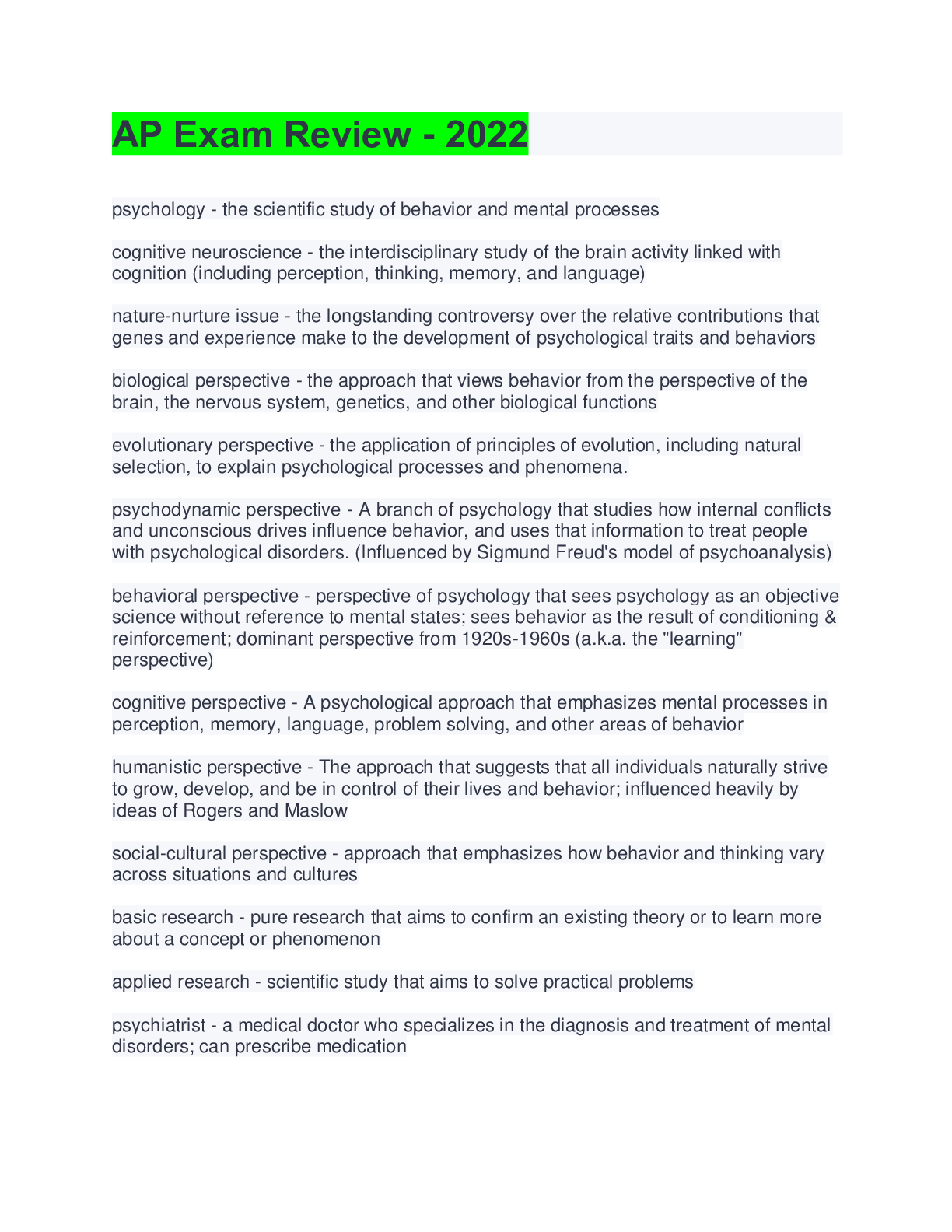
Reviews( 0 )
Document information
Connected school, study & course
About the document
Uploaded On
Oct 14, 2022
Number of pages
63
Written in
Additional information
This document has been written for:
Uploaded
Oct 14, 2022
Downloads
0
Views
41



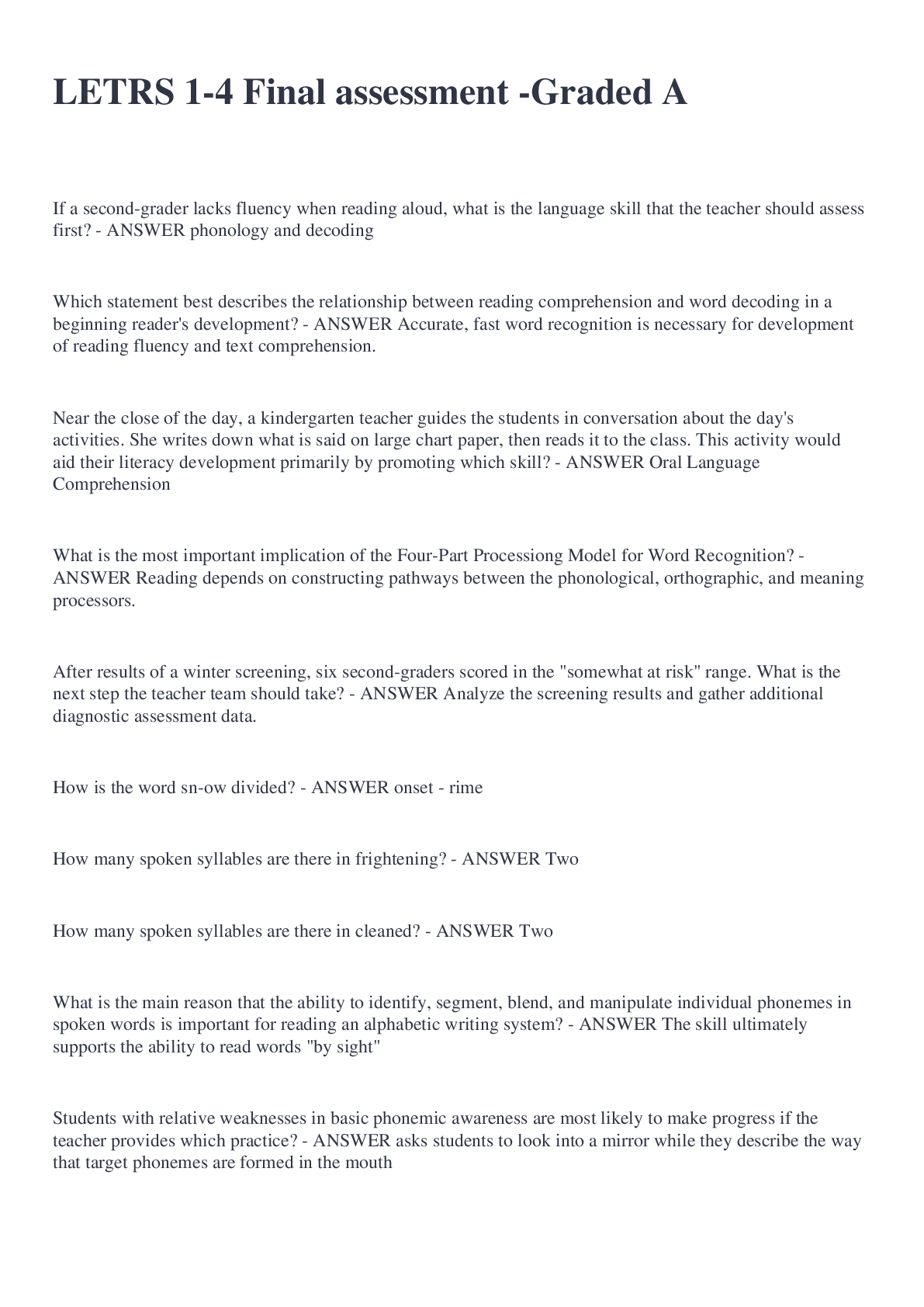


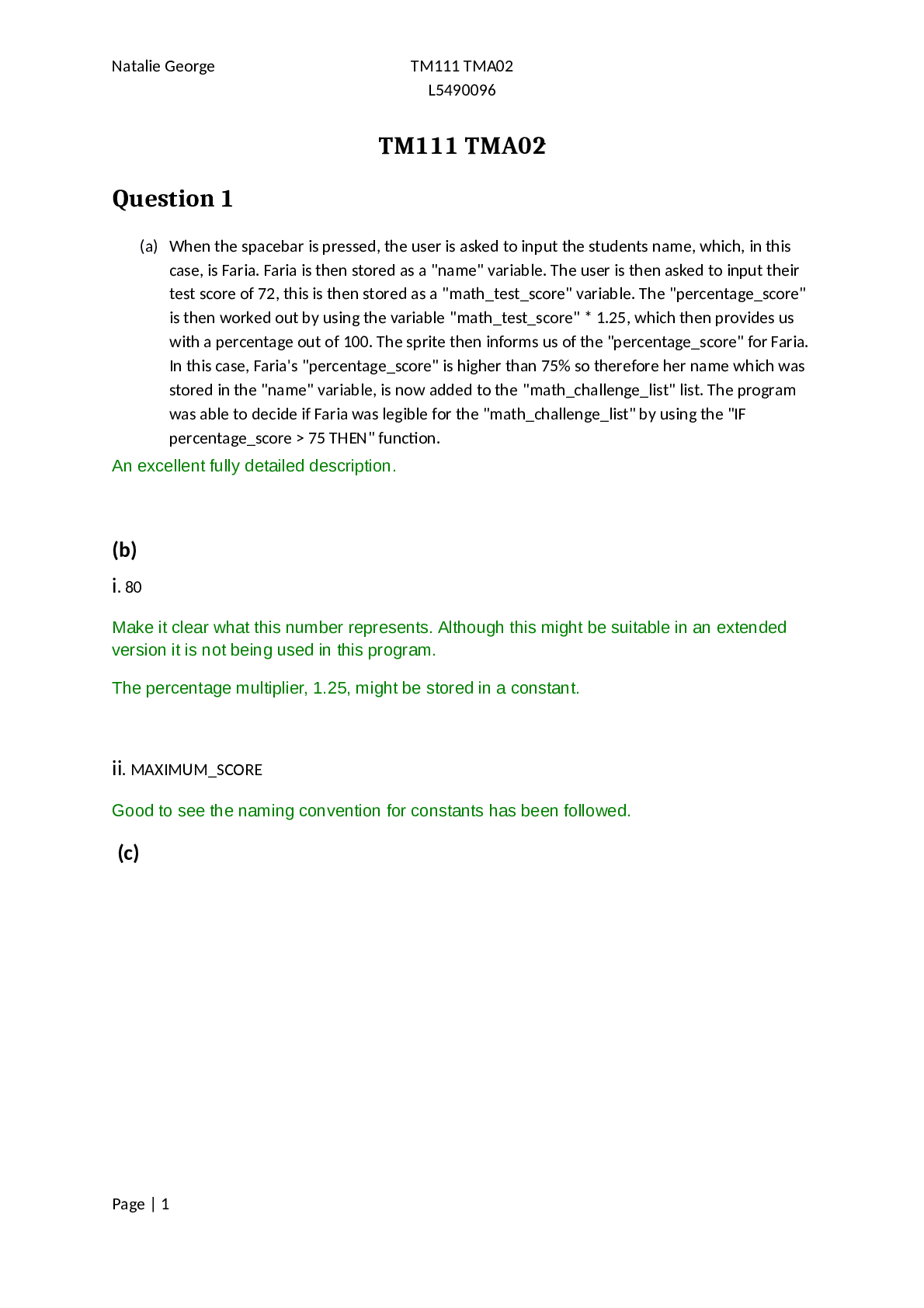


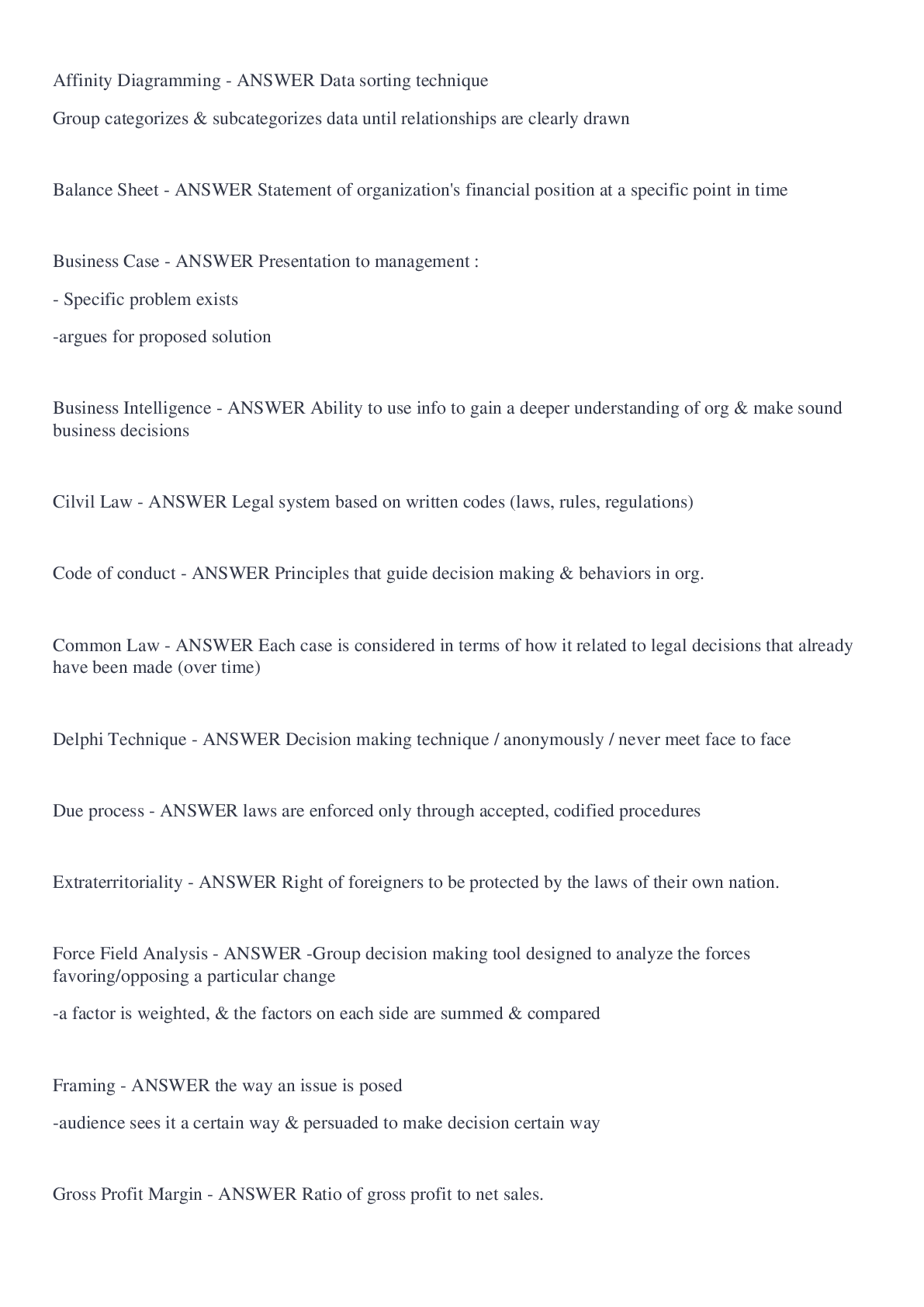

.png)
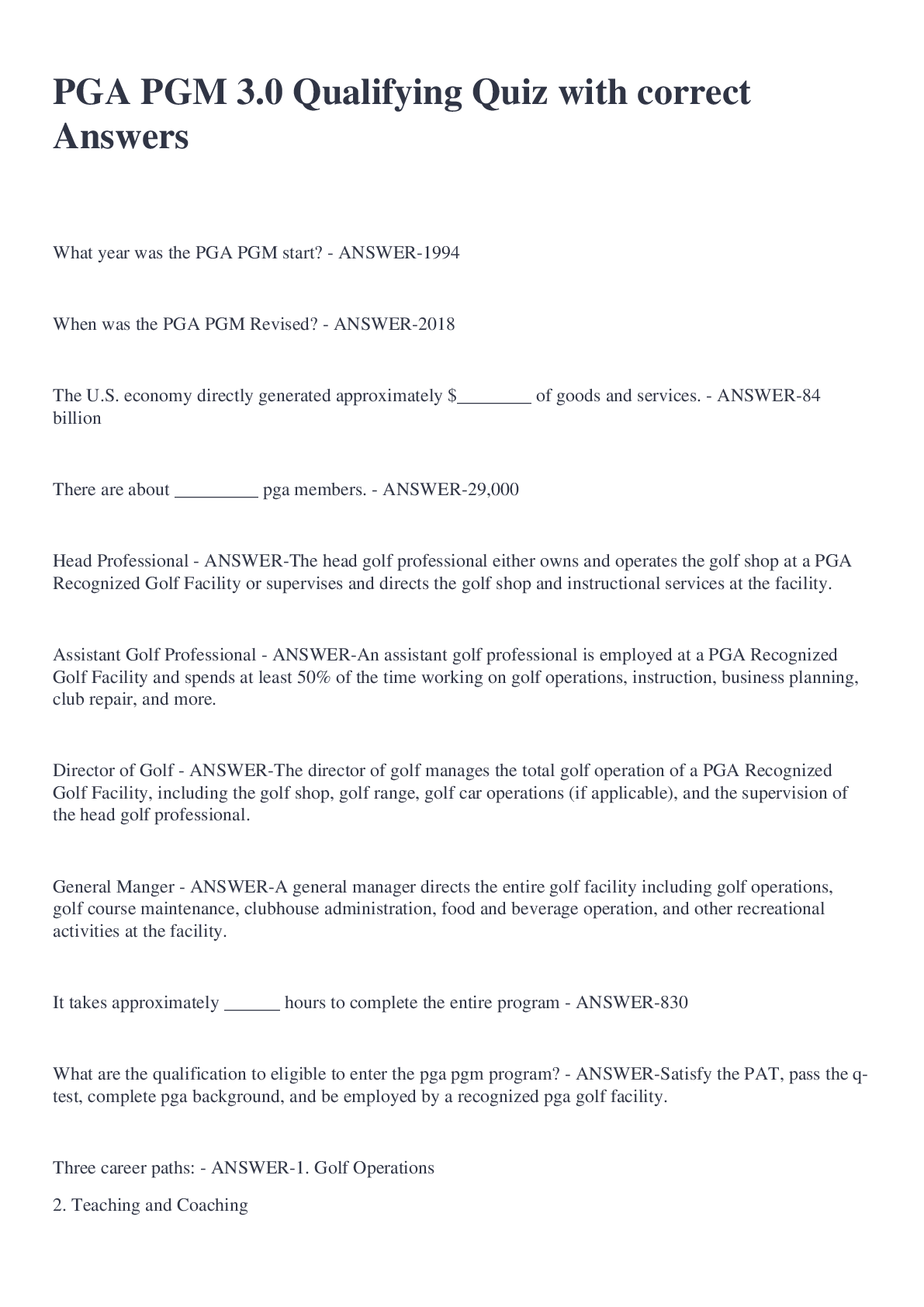
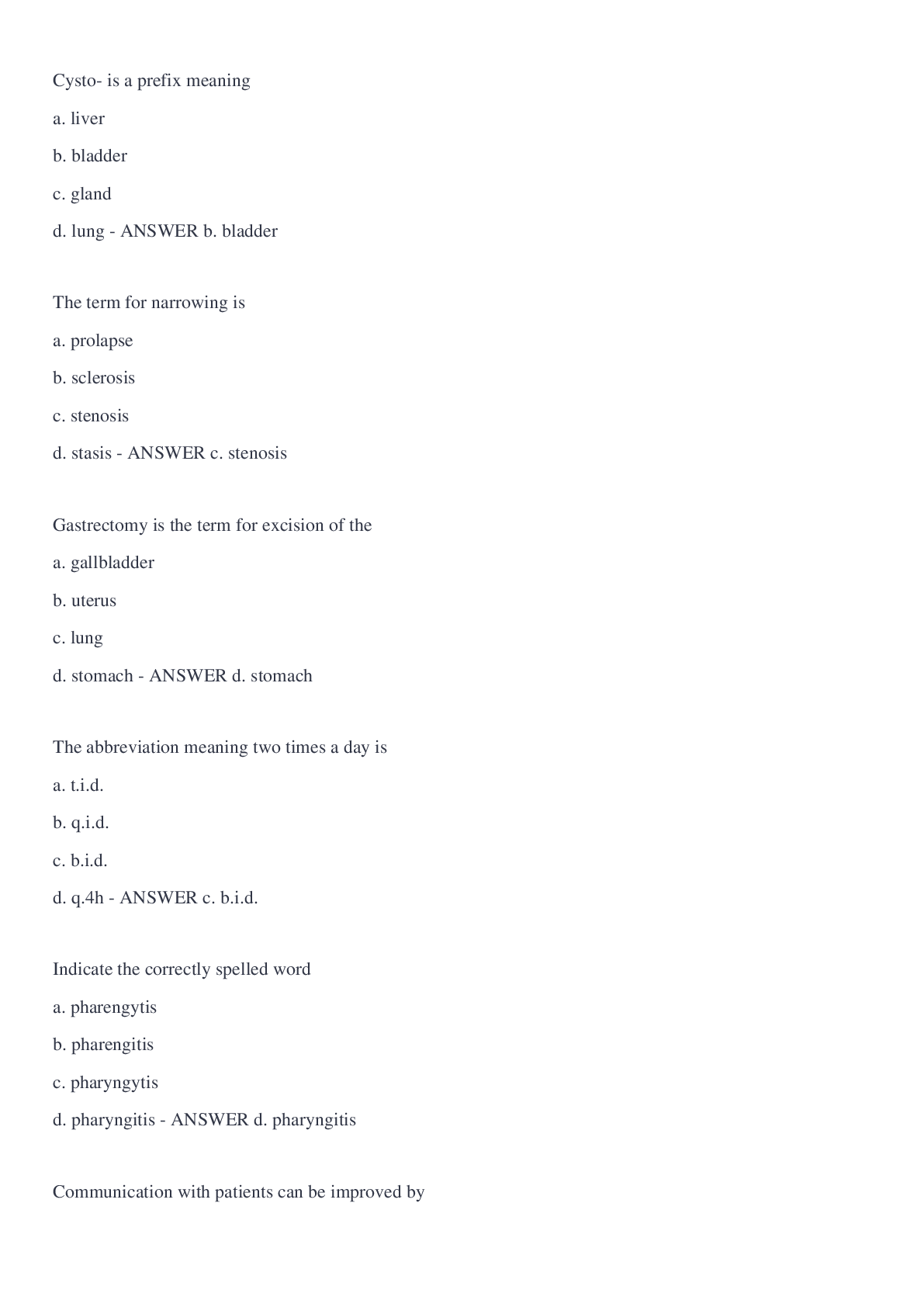


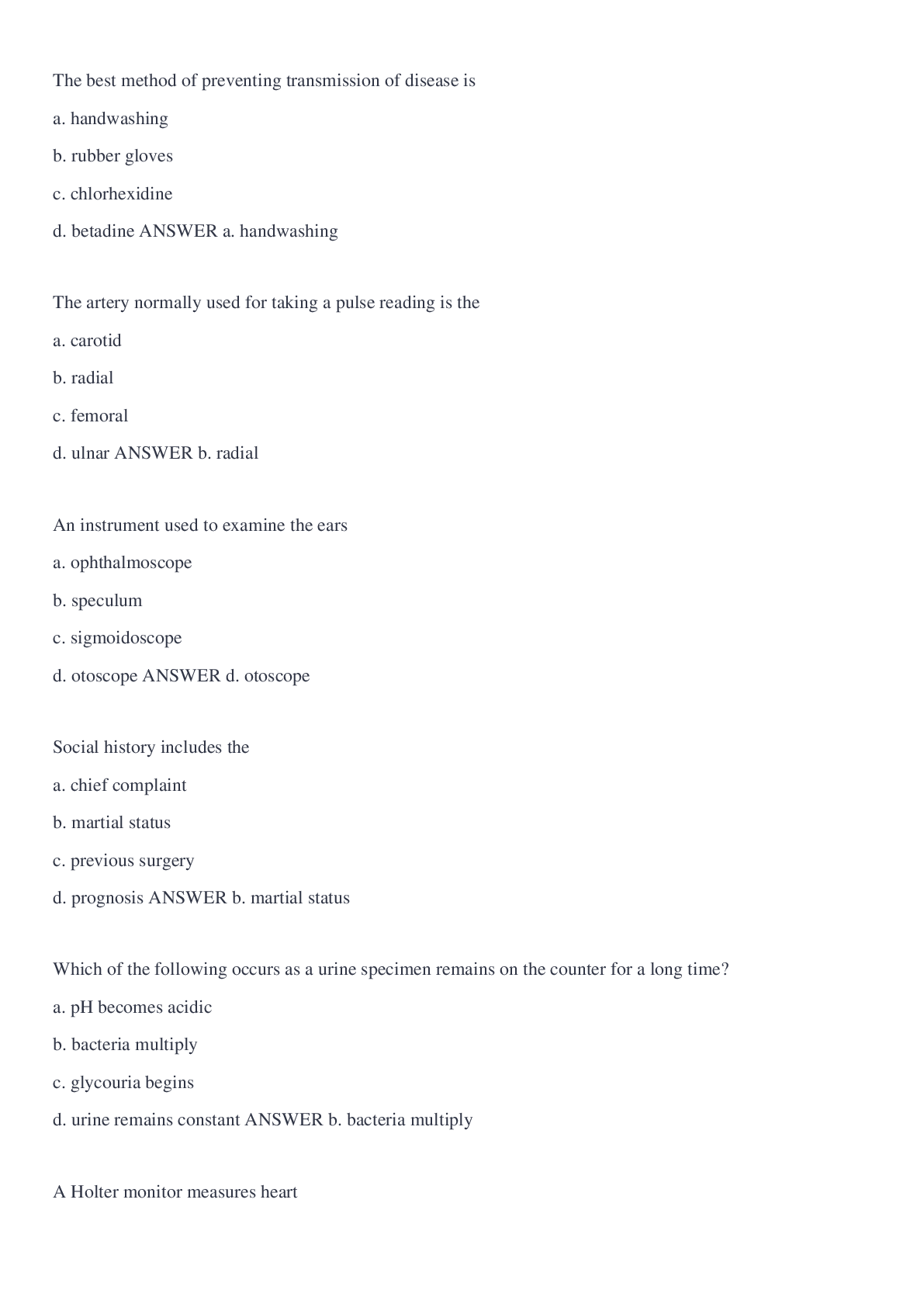


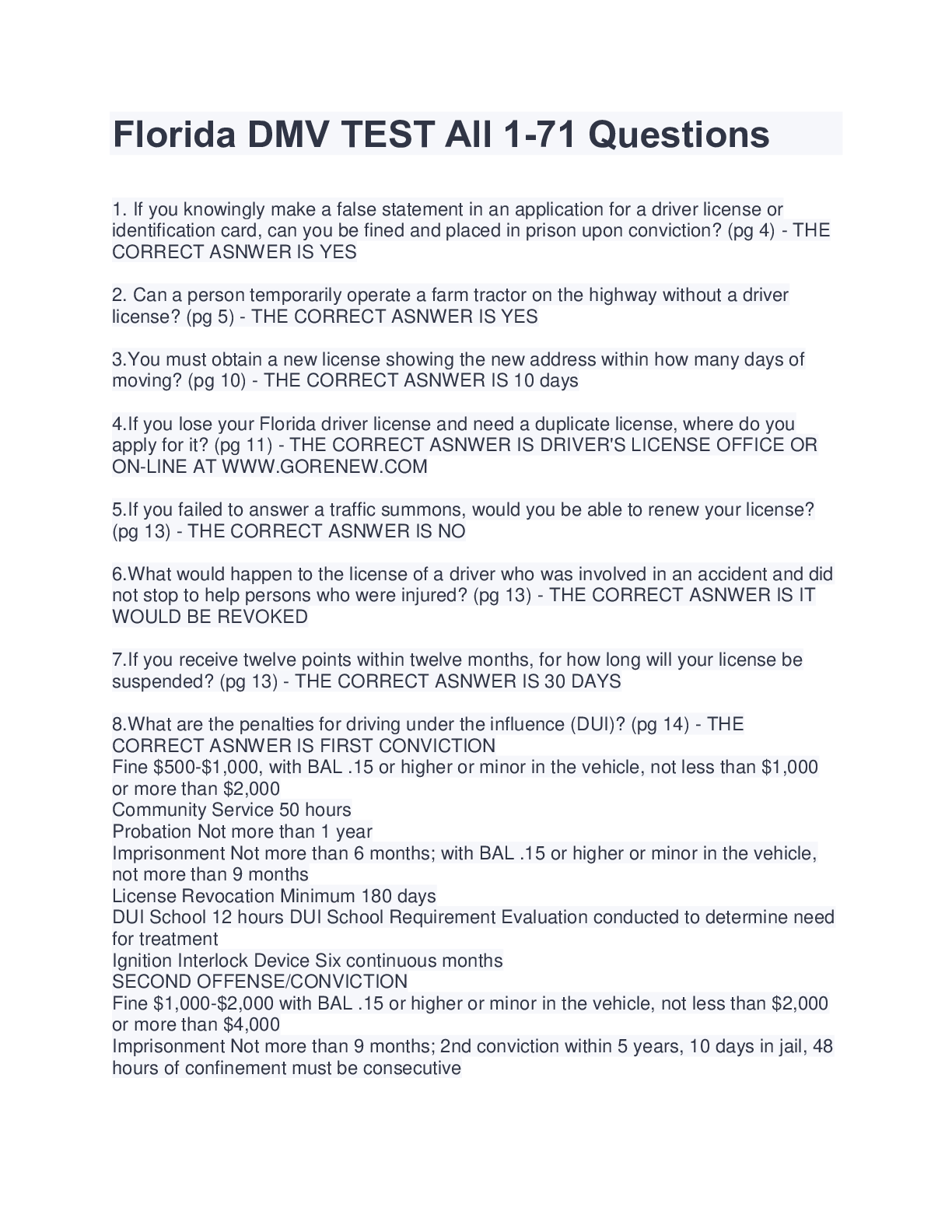
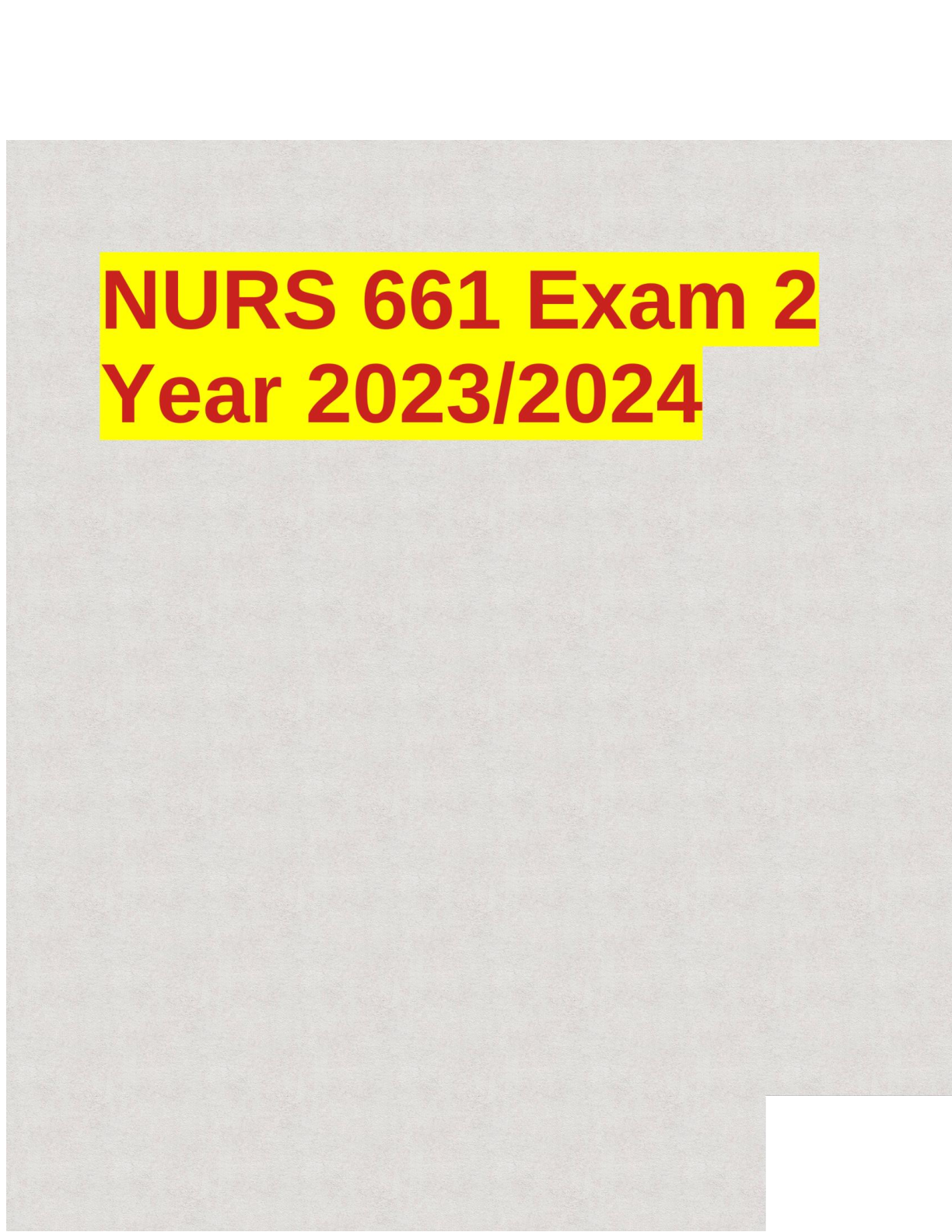

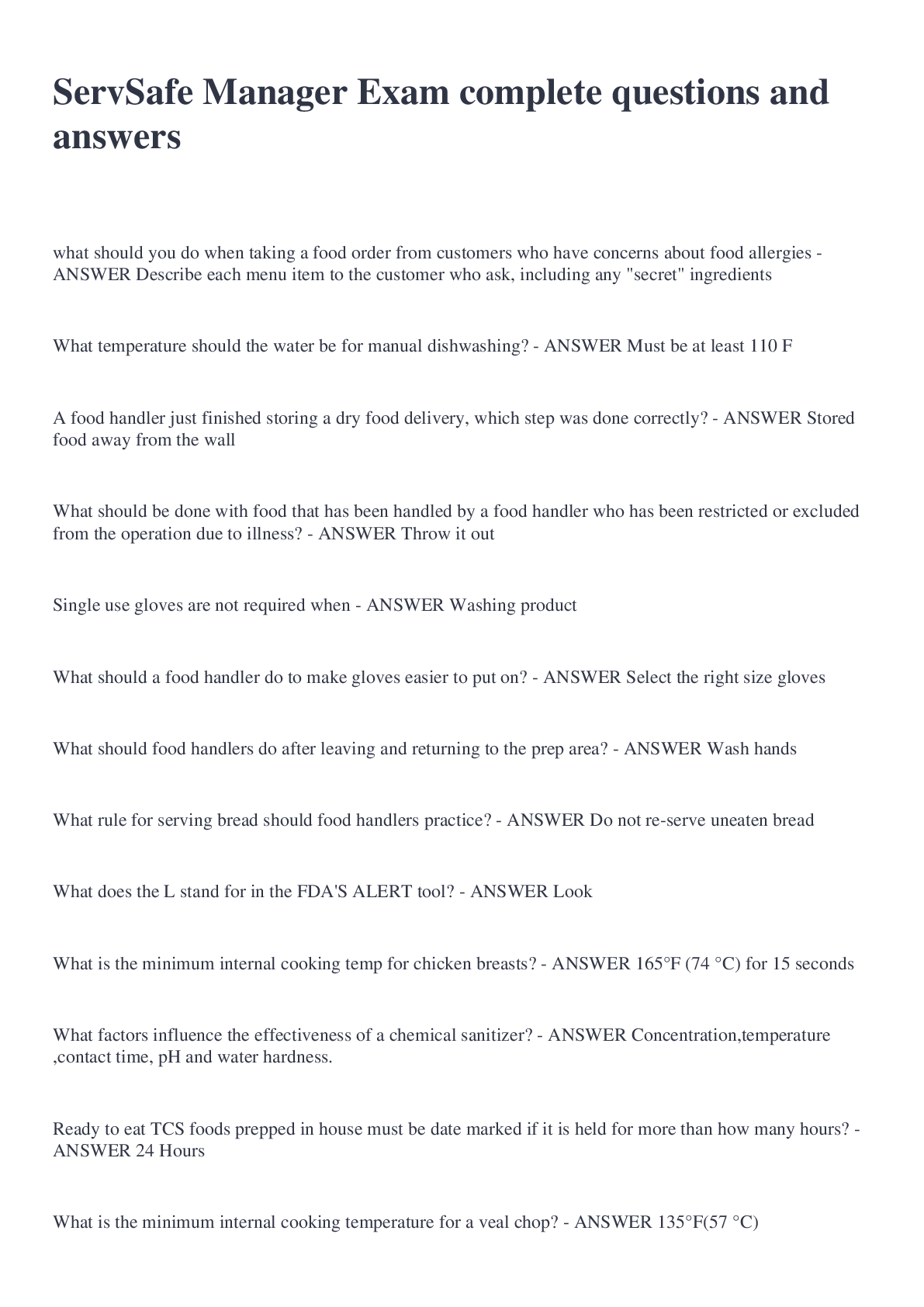


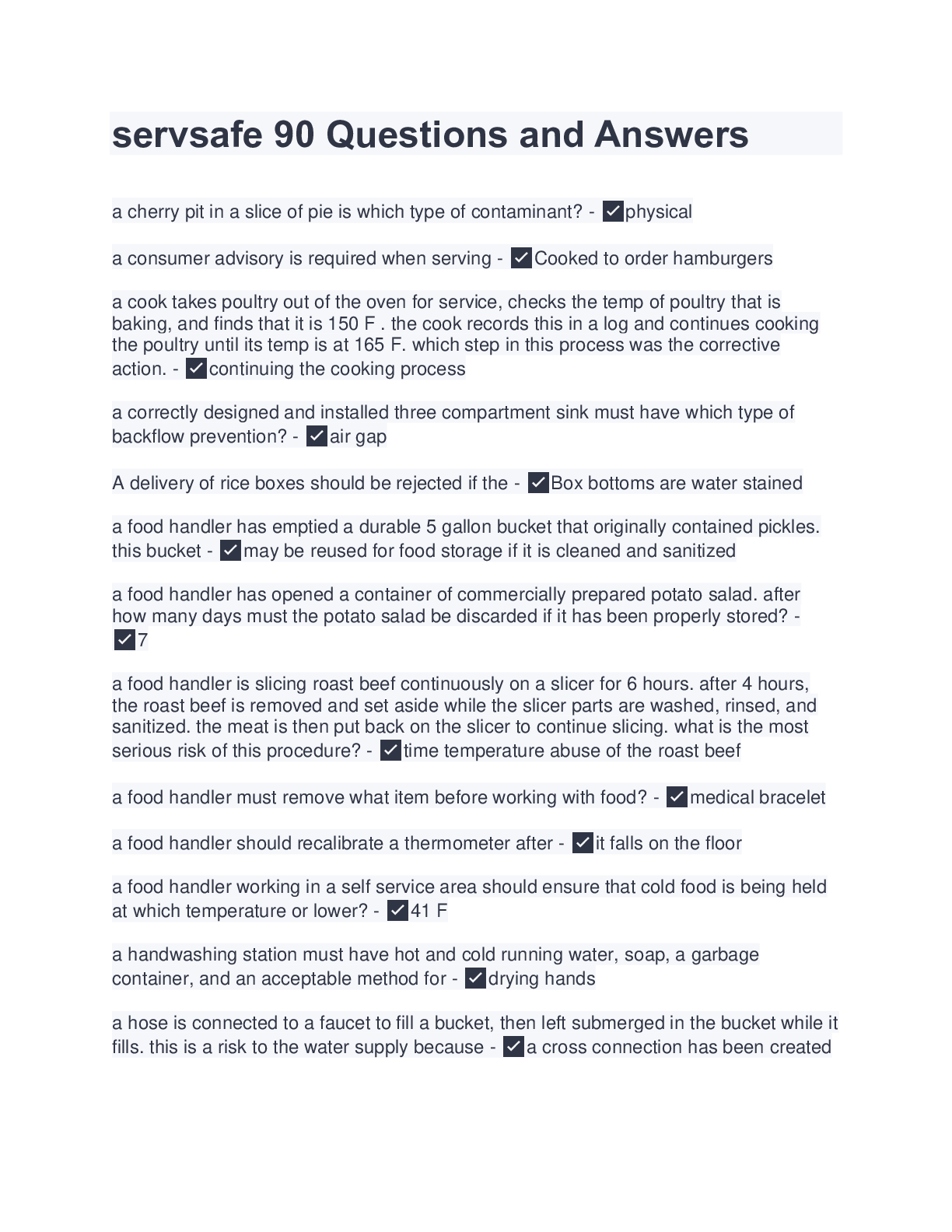
.png)


